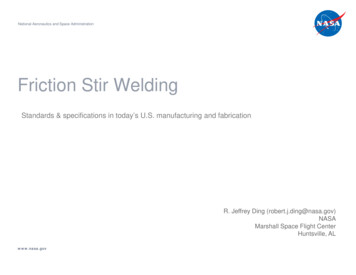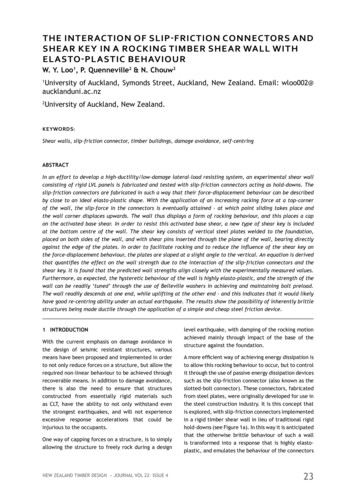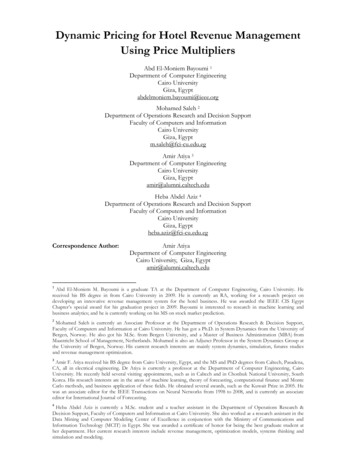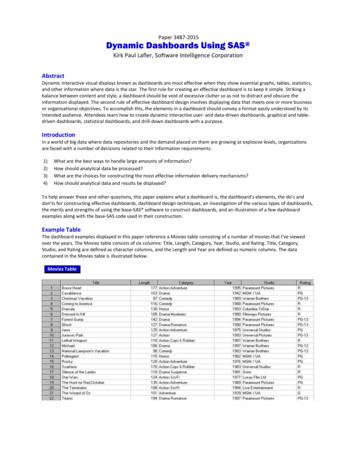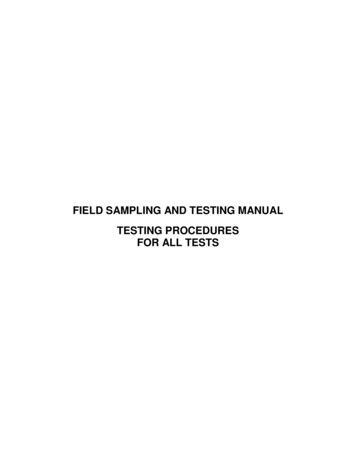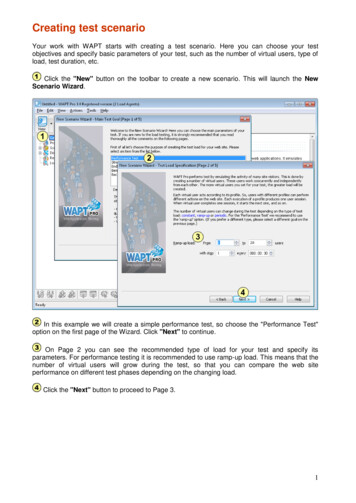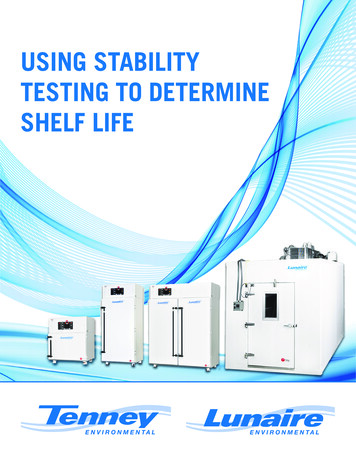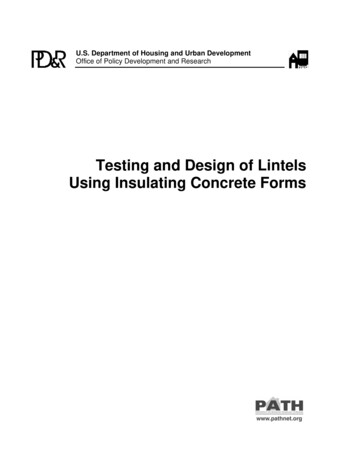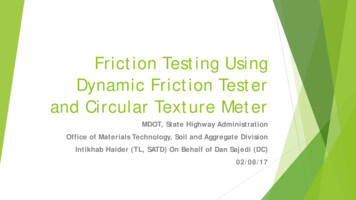
Transcription
Friction Testing UsingDynamic Friction Testerand Circular Texture MeterMDOT, State Highway AdministrationOffice of Materials Technology, Soil and Aggregate DivisionIntikhab Haider (TL, SATD) On Behalf of Dan Sajedi (DC)02/08/17
Why Road Friction is Important 15 to 18 percent of crashesoccur on wet pavements(Smith, 1976; Davis et al., 2002; (FHWA, 1990). Relationship between wet weatheraccidents and pavement friction(Rizenbergs et al.,1972; Giles et al., 1962; McCullough etal., 1966; Wallman and Astron, 2001; Gandhi et al., 1991) An increase in average pavementfriction from 0.4 to 0.55 wouldresult in a 63 percent decrease inwet-pavement crashes(Hall et al., 2006; Miller and Johnson, 1973).
Outlines of Presentation Concept of Road Friction Commonly Used Equipment to Measure Road Friction Practice in Maryland Dynamic Friction Tester Circular Texture/Track Meter Summary
Concept of Road Friction
Concept of Friction on Road Surface
Concept of Friction on Road Surface by FHWA
Calculation of International Friction Index (IFI)
Commonly Used Equipmentto Measure Road Friction
Commonly Used Equipmentto Measure Road FrictionLWSR DFTLocked Wheel Skid Resistance(ASTM E274)(Rib Tire (ASTM E501) and Smooth Tire (ASTM E524)) Dynamic Friction Tester (ASTM E1911) Circular Texture/Track Meter (ASTM E2157) Volumetric Sand Patch Test (ASTM E 965) British Pendulum Tester (ASTM E303, ASTM D3319) Mu-Meter/Cont. FT (ASTM E670)Sand PatchMu-MeterCTMBPN
Practice in Maryland
Practice in Maryland (Up to 2005)(Old Method, Polish Value, MSMT 411)Time required tocomplete PV testing forone aggregate quarrywas almost 3 months.
British Pendulum TestingAccelerated Polishing Machine
Quality Assurance TestingTestFreq.YearStandardWash - #200Gradation1AASHTO T-11 & 27SpecificGravity andAbsorption1AASHTO T-84 & 85L A Test2AASHTO T-96SoundnessTest3AASHTO T-104ASR Test3ASTM C 1260DFT/ PV2ASTM E1911BPN2ASTM E303, E660AIR or Petro2ASTM D3042, C295
Aggregate Evaluation by PolishValue using Maryland Track TestingPolish Value PV 8 – High polish value (HPV) 5 PV 8 -Standard polish value (SPV) 4 PV 5 – Low polish value (LPV)Carbonate/None-Carbonate Rock CarbonateRock: AIR Test Non-carbonate Rock: Petrographic Analysis
Dynamic Friction Tester
Moving From PV to DFVReasons: Expediting Testing Program Labor and Cost Repeatability Production / year Total Quarries 50 Samples Each Quarry 3 min Total DF Testing 150
Research Studies Performed Evaluation Of Laboratory Tests To Quantify FrictionalProperties of Aggregates (July 2010) Aggregate Friction Variability Study (January 2010 ) The Standard Method MSMT-216 ,” Measuring FrictionalProperties of Aggregates Using The Dynamic FrictionTesterMajor References:ASTM E1911, FHWA’s Measuring Instrument Guide, AASHTO“Guide to Pavement Friction”, NCHRP Report 108.
Stepwise Procedure of Dynamic Friction TestingRubber Slider asper ASTM tirestandard for skidresistanceLoad: 3.6kg400X505x430mmGross Wt: 32kg1) Virgin Aggregates, 2) Asphalt Surface, 3) HFST Material, 4) Pavement Marking
Output File of DF Testing
Typical DF Test Results
Polishing Effect On Aggregate Friction
Polish Values Vs DF Values
DFT Verification Testing
Correlation of DFV With Other Properties of Aggregates
Correlation of DFV With Other Properties of Aggregates
Factors That Influence Test Results Material: Change in Physical Properties and Petrography ofmaterials. Equipment:Calibration and Verification TestingProcedure: Uniform- No Change. Replicate samples (2rings /sample) Operator:Technicians.
Current Criteria of Friction Rating in Maryland DFT20 is an indicator of aggregate friction property Preliminary threshold values for aggregate frictionproperty HDFVAggregate: DFT20 40 SDFVAggregate: 25 DFT20 40 LDFVAggregate: DFT20 25 No use for HMA surface: DFT20 25Aggregate for use in HMA surface Petrographic Acidtest (ASTM C-295) for non-carbonate rockinsoluble residue (AIR) Test (ASTM D3042) for carbonate rock
DFT and BPN Field Testing
Comparison of Lab and Field DF Testing
Circular Texture/Track Meter
Mean Profile Depth
Circular Texture MeterIt measures macrotexture of surface in terms of MPD
Output file of CTM Test
CTM and Sand Patch Field Testing
Comparison of CTM Lab and Field Test Results
Summary1.DFT and CTM are reliable, user friendly, less operatordependent testing to measure friction of road surface2.DFT Lab and Field data is comparable with each other.3.CTM Lab and Field data is not comparable with eachother4.The index properties, petrography or AIR test should bereviewed along with DFT and CTM results to rate frictionquality of aggregate quarries5.Friction properties of one quarry can be measured inone week using DFT and CTM testing.
Thanks!!!!!andQuestion?
AASHTO T-11 & 27. Specific Gravity and Absorption: 1. AASHTO T-84 & 85: L A Test. 2: AASHTO T-96. Soundness Test: 3. AASHTO T-104: ASR Test. 3: ASTM C 1260. DFT/ PV: 2. ASTM E1911: BPN. 2: ASTM E303, E660. AIR or Petro: 2. ASTM D3042, C295 : Aggregate Evaluation by Polish Value using Maryland Track Testing Polish Value PV 8 – High polish value (HPV) 5 PV 8 -Standard polish

